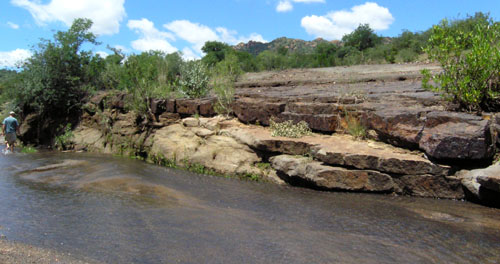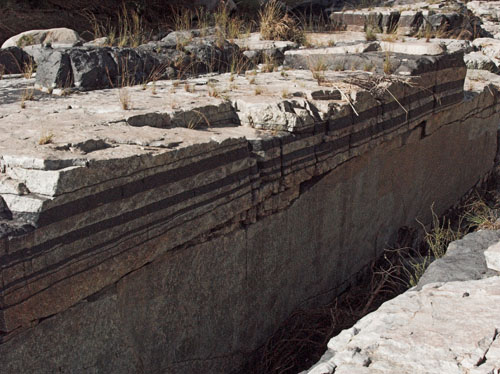 One thing that you can’t help noticing as you travel around the Bushveld complex is that mining is big business; even without looking at the ground, you could map out the two broad arcs of the Rustenburg Layered Suite simply by tracing the line of processing plants and spoil heaps. Given the epic scale of the Bushveld, within the entire 9 km thick pile of layered igneous rocks, it is quite a surprise when you realise that all of this extractive effort is focused almost exclusively on a handful of individual layers, each of which is only a couple of metres thick.
One thing that you can’t help noticing as you travel around the Bushveld complex is that mining is big business; even without looking at the ground, you could map out the two broad arcs of the Rustenburg Layered Suite simply by tracing the line of processing plants and spoil heaps. Given the epic scale of the Bushveld, within the entire 9 km thick pile of layered igneous rocks, it is quite a surprise when you realise that all of this extractive effort is focused almost exclusively on a handful of individual layers, each of which is only a couple of metres thick.
The key thing to understand about economic geology is that the important factor is not so much abundance, as concentration. Your average basalt contains many economically important elements and minerals, but they are present in such minute quantities that you would have to dig up, crush and filter many hundreds, thousands or even tens of thousands of tonnes of rock to obtain even a small amount of them, at which point you would have spent far more than you would possibly earn by selling it – and that’s even before you consider the dire environmental consequences of such an approach. It is only where natural processes have served to concentrate these valuable substances that it is economically viable to mine them. The segregation of different mineral phases by fractional crysallisation, convection and settling within the gargantuan Bushveld magma chamber 2 billion years ago have done precisely that. In some layers the concentrations of what are usually quite minor components of igneous rocks have been increased by several orders of magnitude, a fact which understandably has the mineral extraction folk drooling. Plus, even if the vertical extent of these layers is a little underwhelming, the horizontal extent is not; thin as they are, many of the cumulate layers in the Bushveld can be traced across the entire width and breadth of the intrusion – which, as we’ve seen, is fairly sizable. We’ve met one of these bonanza horizons already – the magnetite layer, which is one of several towards the top of the layered sequence.

The target here is vanadium which has replaced some of the iron in the magnetite lattice, and reaches concentrations of almost 1% in some of the layers. Vanadium is most commonly used as an ingredient in corrosion-resistant alloys of iron and steel.
Lower down in the sequence, the sought-after cumulate layers are composed of chromite:

Unsurprisingly, these horizons are very rich in chromium, which is used to make stainless steel; the Bushveld is the source of 40-50 % of the entire world’s current annual supply. But perhaps even more importantly, some of these layers are also highly enriched in the platinum group elements (PGEs) platinum, palladium, osmium, rhodium, iridium and ruthenium. PGEs are also abundant in the Merensky Reef, another cumulate layer found above the chromites.

PGEs have many important industrial uses: platinum-based catalysts have an important role in synthetic organic chemistry and oil refining, as well as in your car’s catalytic converter. The Merensky Reef and an underlying chromite layer known as UG2 contain around 90% of the world’s known reserves of platinum; thus, most modern cars only pass their emissions tests thanks to two layers, each about a metre and a half thick, from a two billion-year old intrusion here in South Africa. Thank goodness it’s a very large igneous intrusion…



Comments (1)